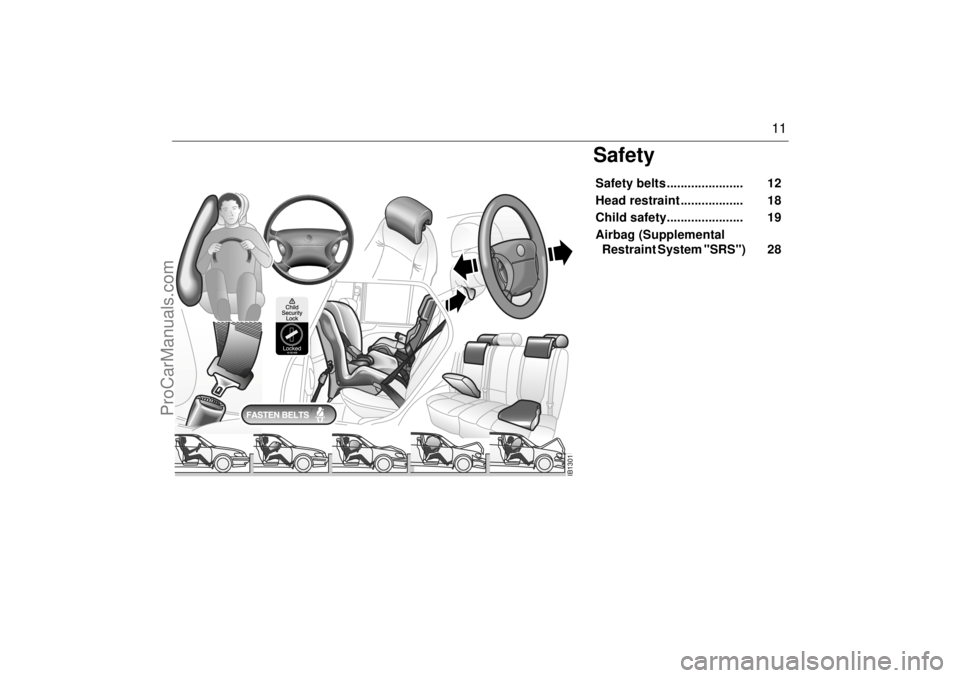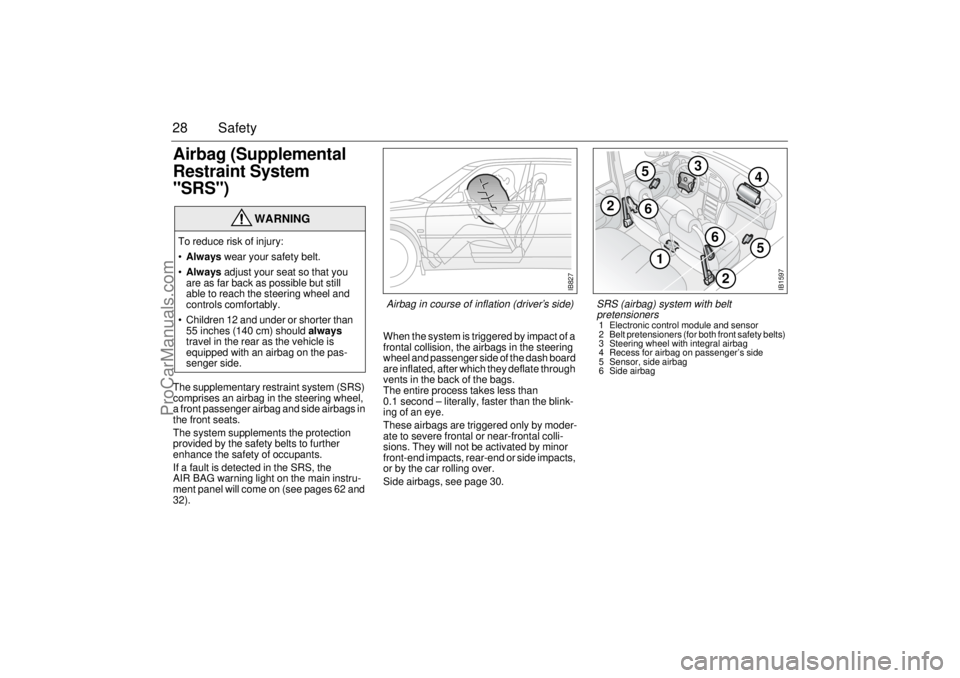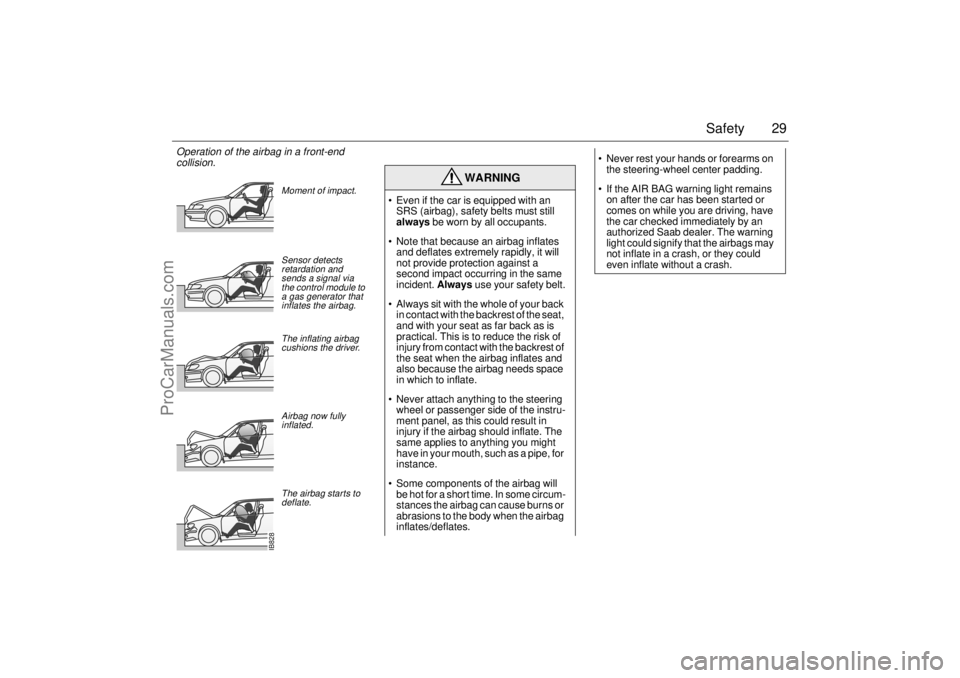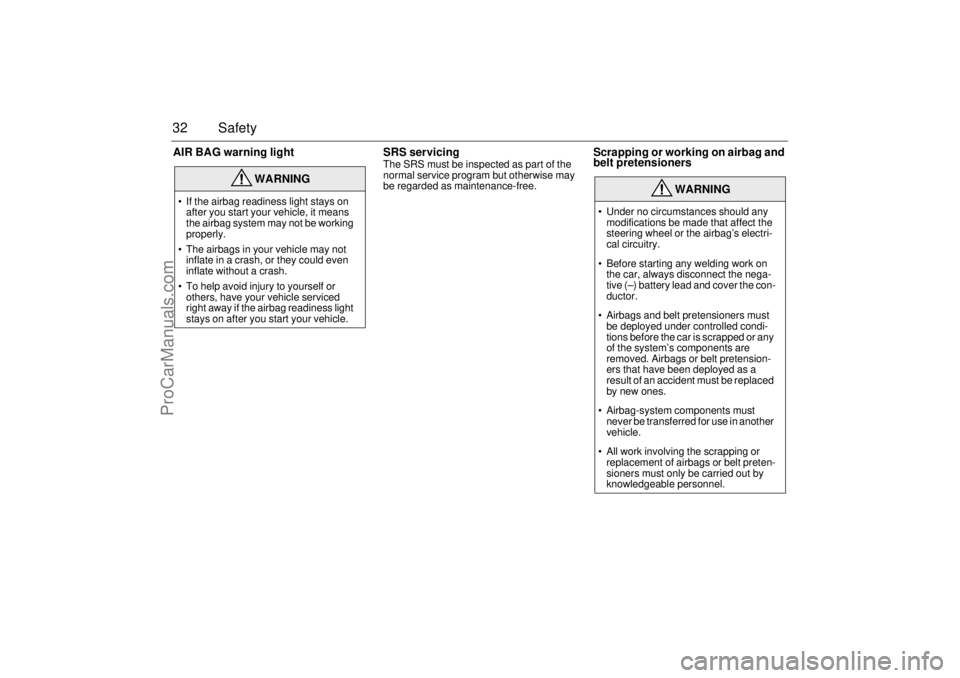airbag SAAB 9-3 2001 Owners Manual
[x] Cancel search | Manufacturer: SAAB, Model Year: 2001, Model line: 9-3, Model: SAAB 9-3 2001Pages: 260, PDF Size: 12.01 MB
Page 5 of 260

5
Interior Power steering _________ 251
Steering-wheel adjustment 137
Airbag _________________ 28
Internal rearview mirror ________ 143
Door mirrors ________________ 143
Vanity mirror ________________ 140
Safety belts _____________ 12
Safety-belt care ________ 224
Airbag _________________ 28
Child seats _____________ 19
Child safety lock catch ____ 39Glove compartment _____ 141Manual transmission ____ 161
Automatic transmission __ 162
IB1353
Seat adjustment ________ 130
Safety belts _____________ 12
Seat heating ___________ 135
Rear seat _____________ 144
Folding down the rear seat 144
Child seats _____________ 19
Upholstery: cleaning _____ 225
Interior lighting switch _________ 139
Interior lighting: changing bulbs __ 210
Center console ______________ 136
Electric windows _____________ 136
Sunroof ____________________ 138
Convertible __________________ 48
Ignition switch _______________ 152
Starting the engine ___________ 153
Engine break-in period ________ 161
Parking ____________________ 174
Driving in hot/cold weather _____ 177
ProCarManuals.com
Page 11 of 260

11
SafetySafety belts ...................... 12
Head restraint .................. 18
Child safety...................... 19
Airbag (Supplemental
Restraint System "SRS") 28
IB1301
ProCarManuals.com
Page 19 of 260

19 Safety
Child safety
Car safety tips Protect your children from getting
trapped in the trunk of a car
WARNING
Children must always be suitably
restrained in the car. All child
restraints and booster seats are
designed to be secured in vehicle
seats by the lap belt or the lap belt of a
lap-shoulder belt. If the child restraint
is not properly secured, a child can be
endangered in a crash.
NEVER put a child seat in the front.
Children 12 and under can be killed by
the airbag.
According to accident statistics, the
BACK SEAT is SAFER for properly
restrainen children than the front seat.
Sit as far back as possible from the air
bag.
WARNING
Never leave your children unattended
in a car, even for a short time.
– Children can suffer heat stroke - per-
haps die - in a matter of minutes.
– Children can put the car into gear and
hurt themselves or others.
At gas stations, take the keys from the
car while filling the tank.
Never allow children to climb on top of -
or under motor vehicles.
Always look for children before backing
your motor vehicle out of a garage or
driveway.
To avoid carbon monoxide poisoning,
never let a car idle in the garage.
Supervise young children around buck-
ets of water while washing your car.
Small children can drown in seconds in
less than an inch of water.
WARNING
Teach your kids not to play in or around
cars.
Watch your children when loading or
unloading the car so they don´t get
locked in by mistake.
Always lock the doors and trunk of your
car, and keep the keys out of children´s
sight and reach.
Keep the rear fold-down seats closed
to help prevent kids from getting into
the trunk from inside the car.
ProCarManuals.com
Page 28 of 260

28 SafetyAirbag (Supplemental
Restraint System
"SRS") The supplementary restraint system (SRS)
comprises an airbag in the steering wheel,
a front passenger airbag and side airbags in
the front seats.
The system supplements the protection
provided by the safety belts to further
enhance the safety of occupants.
If a fault is detected in the SRS, the
AIR BAG warning light on the main instru-
ment panel will come on (see pages 62 and
32). When the system is triggered by impact of a
frontal collision, the airbags in the steering
wheel and passenger side of the dash board
are inflated, after which they deflate through
vents in the back of the bags.
The entire process takes less than
0.1 second – literally, faster than the blink-
ing of an eye.
These airbags are triggered only by moder-
ate to severe frontal or near-frontal colli-
sions. They will not be activated by minor
front-end impacts, rear-end or side impacts,
or by the car rolling over.
Side airbags, see page 30.
WARNING
To reduce risk of injury:
Always wear your safety belt.
Always adjust your seat so that you
are as far back as possible but still
able to reach the steering wheel and
controls comfortably.
Children 12 and under or shorter than
55 inches (140 cm) should always
travel in the rear as the vehicle is
equipped with an airbag on the pas-
senger side.
IB827
Airbag in course of inflation (driver’s side)
IB1597
5
1
4
2
6
3
2
6
5
SRS (airbag) system with belt
pretensioners 1 Electronic control module and sensor
2 Belt pretensioners (for both front safety belts)
3 Steering wheel with integral airbag
4 Recess for airbag on passenger’s side
5 Sensor, side airbag
6 Side airbag
ProCarManuals.com
Page 29 of 260

29 Safety
WARNING
Even if the car is equipped with an
SRS (airbag), safety belts must still
always be worn by all occupants.
Note that because an airbag inflates
and deflates extremely rapidly, it will
not provide protection against a
second impact occurring in the same
incident. Always use your safety belt.
Always sit with the whole of your back
in contact with the backrest of the seat,
and with your seat as far back as is
practical. This is to reduce the risk of
injury from contact with the backrest of
the seat when the airbag inflates and
also because the airbag needs space
in which to inflate.
Never attach anything to the steering
wheel or passenger side of the instru-
ment panel, as this could result in
injury if the airbag should inflate. The
same applies to anything you might
have in your mouth, such as a pipe, for
instance.
Some components of the airbag will
be hot for a short time. In some circum-
stances the airbag can cause burns or
abrasions to the body when the airbag
inflates/deflates.
Never rest your hands or forearms on
the steering-wheel center padding.
If the AIR BAG warning light remains
on after the car has been started or
comes on while you are driving, have
the car checked immediately by an
authorized Saab dealer. The warning
light could signify that the airbags may
not inflate in a crash, or they could
even inflate without a crash.
Operation of the airbag in a front-end
collision.
Moment of impact.
Sensor detects
retardation and
sends a signal via
the control module to
a gas generator that
inflates the airbag.
The inflating airbag
cushions the driver.
Airbag now fully
inflated.
The airbag starts to
deflate. IB828
ProCarManuals.com
Page 30 of 260

30 SafetyFront passenger seat The airbags are interconnected and have a
common warning light, AIR BAG. The pas-
senger airbag module is housed in the
fascia above the glove compartment and is
marked ”SRS AIR BAG”.
Both airbags will be inflated in the event of a
moderate to severe frontal, or near-frontal
collision, even if the passenger seat is unoc-
cupied.
Side airbag
WARNING
Never secure a rear-facing child seat in
the right front seat of a car equipped with
a passenger airbag. Inflation of the airbag
in the event of an accident could seriously
injure or kill a child.
WARNING
Children 12 and under can be killed by
the airbag.
The back seat is the safest place for
children.
Never allow a child to stand in front of
the seat or to sit on the lap of a
front-seat passenger. Serious injury or
death could result if the airbag is
inflated in a collision.
The glove compartment must be
closed while travelling. An open
glove-compartment door could cause
leg injuries in the event of a collision.
Never place anything on the dash or in
front of the seat as, in addition to being
a hazard to passengers, this could
interfere with the function of the airbag
in the event of an accident. The same
applies to the mounting of accessories
on the dash.
Keep feet on the floor - never put feet
up on the dash, on the seat or out of
the window.
Do not carry anything in your lap.
WARNING
This car is equipped with side airbags
and no extra interior trim should be fit-
ted. Failure to observe this warning
could result in the side airbags not
inflating as intended and thus not pro-
viding the intended protection either.
Never place any object in the area that
would be occupied by the inflated air-
bag.
For optimum protection, sit upright in
the seat, with your safety belt correctly
fastened.
The sensors for the side airbags are
fitted in the front doors.
IB986
ProCarManuals.com
Page 31 of 260

31 Safety
Side airbags are housed inside the back-
rests of the front seats and are designed to
protect the driver and front passenger in the
event of a side impact.
In a side impact, only the airbag on that side
will be activated, and only then if certain pre-
determined conditions are met such as the
force and angle of the impact, the speed of
the car on impact, and at which point on the
car’s side the impact occurs.
The sensors, which are fitted in the front
doors, sense the rise in pressure caused by
the door panel being pressed in during an
impact condition. The side airbag trigger will
be commanded based on the characteris-
tics of this pressure rise. We advise against doing any work on
the doors that could affect the mois-
ture barrier in the door or the airbag
sensors. It is essential that the mois-
ture barrier (thick plastic film) in the
front door is not damaged in any way.
Improvement of the anticorrosion
treatment of the doors should only be
carried out by an authorized Saab
dealer. Otherwise there is a risk that
the side impact sensor and the mois-
ture barrier in the door could be dam-
aged.
The side airbags will inflate only in the
event of a side impact; not in the event
of a front or rear-end collision or of the
car’s rolling over.
Wear and damage to the seat cover,
or the seat seam, in the area of the
side airbag must immediately be
repaired by an authorized Saab
dealer.
Do not modify the speaker installation
in the front doors or install speakers
other than those specifically approved
by Saab.
IB1707
Side airbag, components 1 Side airbags (SRS)
2 Sensor
3 Moisture barrier
4 Text on
ProCarManuals.com
Page 32 of 260

32 SafetyAIR BAG warning light SRS servicing
The SRS must be inspected as part of the
normal service program but otherwise may
be regarded as maintenance-free.
Scrapping or working on airbag and
belt pretensioners
WARNING
If the airbag readiness light stays on
after you start your vehicle, it means
the airbag system may not be working
properly.
The airbags in your vehicle may not
inflate in a crash, or they could even
inflate without a crash.
To help avoid injury to yourself or
others, have your vehicle serviced
right away if the airbag readiness light
stays on after you start your vehicle.
WARNING
Under no circumstances should any
modifications be made that affect the
steering wheel or the airbag’s electri-
cal circuitry.
Before starting any welding work on
the car, always disconnect the nega-
tive (–) battery lead and cover the con-
ductor.
Airbags and belt pretensioners must
be deployed under controlled condi-
tions before the car is scrapped or any
of the system’s components are
removed. Airbags or belt pretension-
ers that have been deployed as a
result of an accident must be replaced
by new ones.
Airbag-system components must
never be transferred for use in another
vehicle.
All work involving the scrapping or
replacement of airbags or belt preten-
sioners must only be carried out by
knowledgeable personnel.
ProCarManuals.com
Page 33 of 260

33 Safety
Frequently asked questions on func-
tion of the airbagDo you still need to wear a safety belt if air-
bags are fitted? Yes, always! The airbag merely supple-
ments the car’s normal safety system.
Moreover, the airbag will only be actuated in
a moderate to severe frontal, or near-frontal
collision, which means, of course, that it pro-
vides no protection in minor frontal colli-
sions, major rear-end or side-on collisions
or if the car rolls over.
The safety belts help reduce the chance of
the car occupants from being thrown around
and injured inside the car.
But they also ensure that, if a collision
occurs in which the airbags are inflated, the
airbag will make the optimum contact with
the occupant, i.e. square on from the front.
If the occupant meets the airbag in an offset
position, the protection afforded will be
reduced.
In addition, airbags provide no protection
against a secondary impact occurring in the
same incident. So there is no doubt about
the benefit of wearing safety belts at all
times.
Do not sit too close to the airbag: it needs
room to inflate.
The airbag inflates very quickly and power-
fully in order to protect an adult person in a
serious frontal collision.
How do I position the seat to leave room for
the airbag to inflate?Don’t have your seat too far forward.
Recline the seat back to increase the dis-
tance between you and the airbag. For short
drivers, special accessory pedal extensions
are available through your Saab dealer.
Airbags inflate extremely rapidly and with
great force - to be fast enough to protect an
adult in the seat. When do the airbags in the steering wheel
and passenger side of the dash board
inflate? The airbag will only be inflated under certain
predetermined conditions in a moderate to
severe frontal, or near-frontal collision,
depending on such factors as the force and
angle of the impact, the speed of the car on
impact, and the resistance to deformation of
the impacting object.
The airbag can only be activated once in the
same incident.
Do not attempt to drive the car after an
airbag has been inflated, even if it is possi-
ble.
What won’t trigger the airbag? The airbag will not be activated in all
front-end collisions. For instance, if the car
has hit something relatively soft and yielding
(e.g. a snow drift or a hedge) or a solid
object at a low impact speed, the airbag will
not necessarily be triggered. How loud is the inflation? The noise of the inflation is certainly loud,
but it is very short-lived and will not damage
your hearing. For a short time afterwards
you could experience a buzzing noise in
your ears.
Most people who have experienced it
cannot remember the noise of the inflation
at all - all they remember is the noise of the
crash. Can you still use a child seat in the front if a
passenger airbag is installed? Definitely not!
Children 12 and under can be injured or
killed by the airbag.
The BACK SEAT is the SAFEST place for
children.
NEVER put a child seat in the front.
ProCarManuals.com
Page 34 of 260

34 SafetyAre the smoke and fumes given off when the
airbag operates at all harmful? Most people who have remained in a car
with little or no ventilation for several min-
utes complained only of minor irritation of
the throat and eyes. Avoid as much as pos-
sible getting dust on your skin as there is a
risk of skin irritation.
If this trouble persists, you should consult a
doctor.
If you suffer from asthma, the incident may
bring on an attack, in which case you should
follow the normal procedure advised by
your doctor. It is advisable to consult a
doctor afterwards.
What should I do if the AIR-BAG warning
light comes on? If the warning light is on, it means that a fault
has been detected in the system. The
airbag cannot be relied on to operate as
intended and it might even be activated
erroneously. You should therefore take the
car to an authorized Saab dealer as soon as
possible.
WARNING
When an airbag is inflated there is dust in
the air.
Because the dust/smoke can, in certain
cases, cause irritation to the skin, the fol-
lowing precautions should be taken:
As soon as possible, wash any
exposed skin using a mild soap and
water.
If there is irritation of the eyes, flush
them liberally with clean water for at
least 20 minutes.
ProCarManuals.com